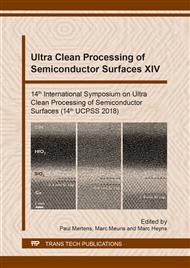p.278
p.284
p.288
p.295
p.300
p.309
p.314
p.321
p.329
Determination of HCl Transport Coefficients in Real FOUP Polymers for HCl Cross-Contamination Assessment from FOUP to Wafer
Abstract:
The HCl transport coefficients of commercial FOUPs made of polymers such as polycarbonate (PC), Entegris Barrier Material (EBM) and composite of Entegris Barrier Material/carbon nanotubes (EBMCNT)) were experimentally determined by the sorption kinetic method taking into account the surface effect. Afterward, these transport coefficients were used as input data for the membrane polymer model. The HCl concentration profiles within different FOUPs polymers were simulated in different contamination scenarios, queue time and purge steps. Having the polar group in polymeric chains, PC showed a higher affinity to HCl rather than EBM and EBMCNT, leading to a higher HCl diffusivity. According to simulation data, the HCl contaminant, therefore, penetrates deeper into FOUPs walls made of PC. In contrary, the EBM and EBMCNT have low HCl penetrating depth and the total HCl uptake mass is mostly present near the surface (< 20 µm) for EBM and EBMCNT. In addition, the transferred HCl onto Cu-coated wafers stored in PC and EBMCNT FOUPs was also discussed and compared.
Info:
Periodical:
Pages:
321-328
Citation:
Online since:
August 2018
Price:
Сopyright:
© 2018 Trans Tech Publications Ltd. All Rights Reserved
Share:
Citation:


